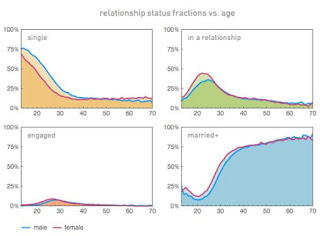So our data does show us who we really are. New data and analysis
I have written about the fact that Social Networks offer insights into how we humans interact with each other many times as they have unparalleled access to real time data.
New analysis from Wolfram Alpha, has examined usage habits and found that it as we expected, but have the data to prove it. Here’s a summary of some of the more notable findings, some of which are depressingly stereotypical, according to Wolfram Alpha designer Stephen Wolfram.
The median number of Facebook friends is 342, a number that varies based on how old you are: Teenagers tend to have more friends than adults do. When you’re younger, most of your friends are your own age, but the range of ages broadens as you get older.
Teenage boys tend to have more friends than teenage girls, but that difference disappears as they get older. The older you get, the more likely you are to be married; women get married earlier than men; and, by 30, about 70 percent of people are married. (“It’s as if all those humans, with all the complexities of their lives, still behave in aggregate a bit like molecules—with certain “reaction rates” to enter into relationships, marry, etc,” Wolfram says.)
As people get older, they talk less about things like video games and more about politics, weather, health, and money. Men love to talk about sports and technology, while women tend to talk about pets, family, relationships, and their personal moods.
What’s worth keeping in mind here is this data is limited to the small number of Facebook users who let Wolfram Alpha use it. Similar to the data that OkCupid periodically releases about how people use the service, all of these findings also confirm that our social networks know more about us than we do ourselves. “But what to me is remarkable is how we can see everything laid out in such quantitative detail in the pictures above — kind of a signature of people’s thinking as they go through life,” Stephen Wolfram writes.


